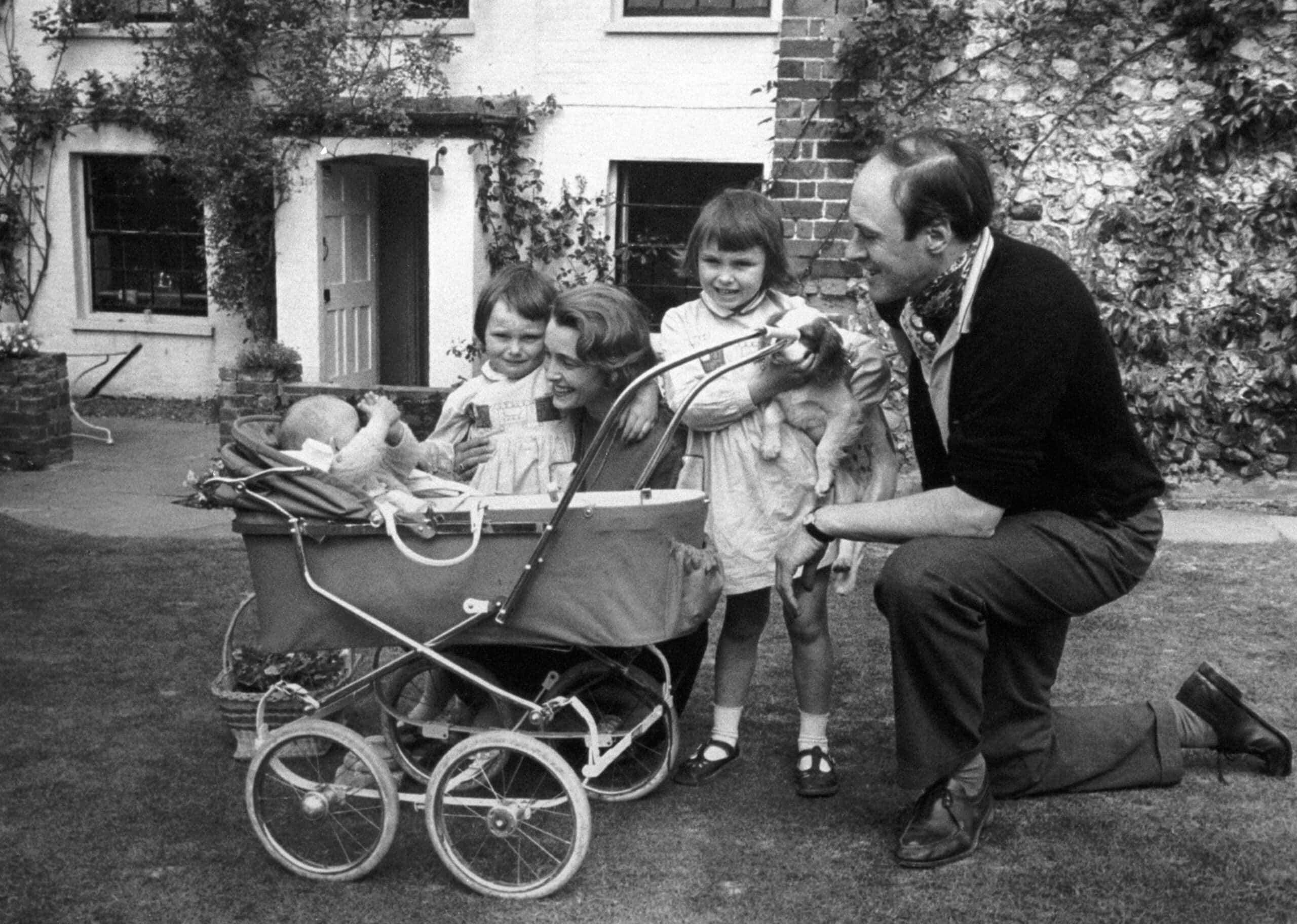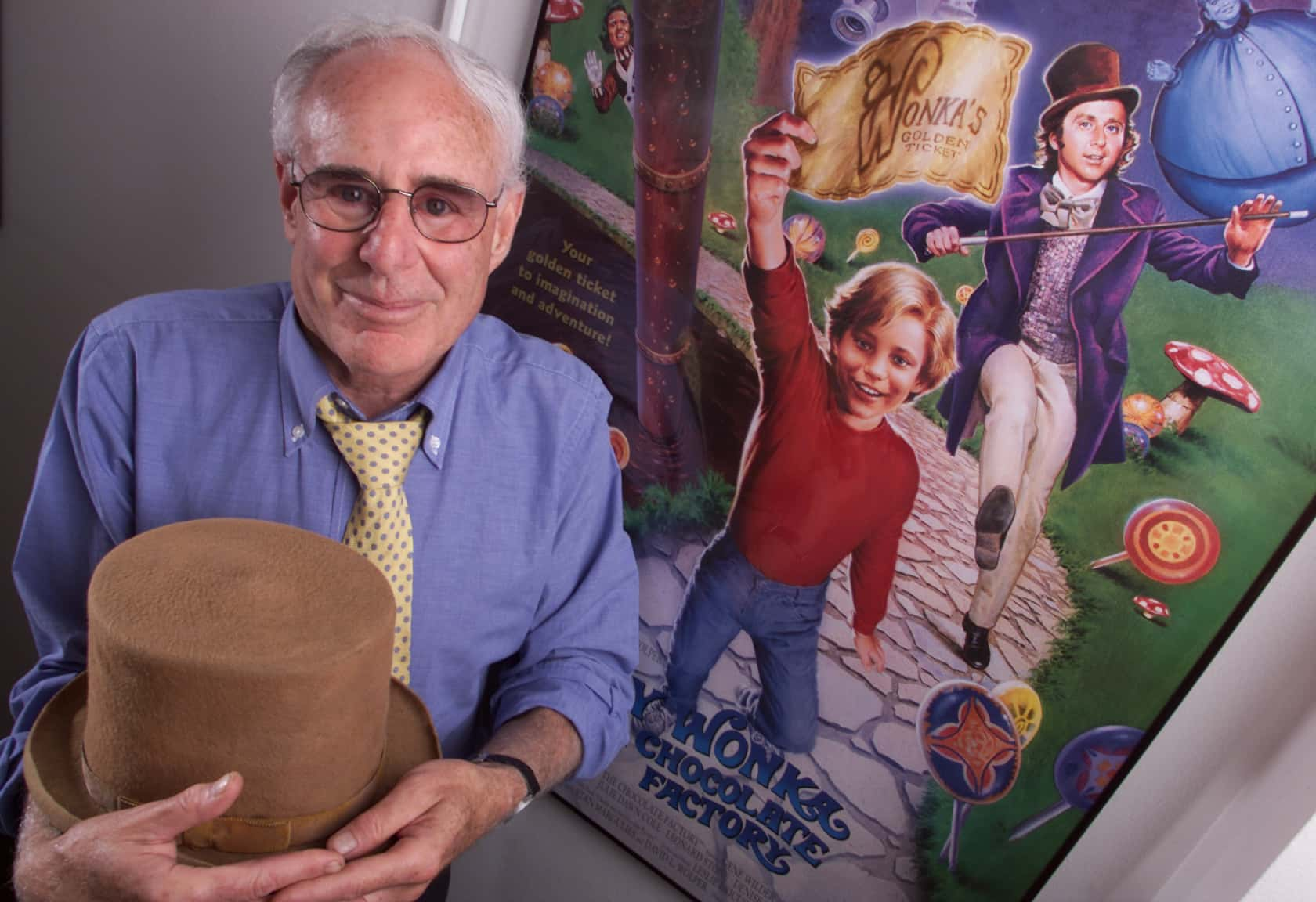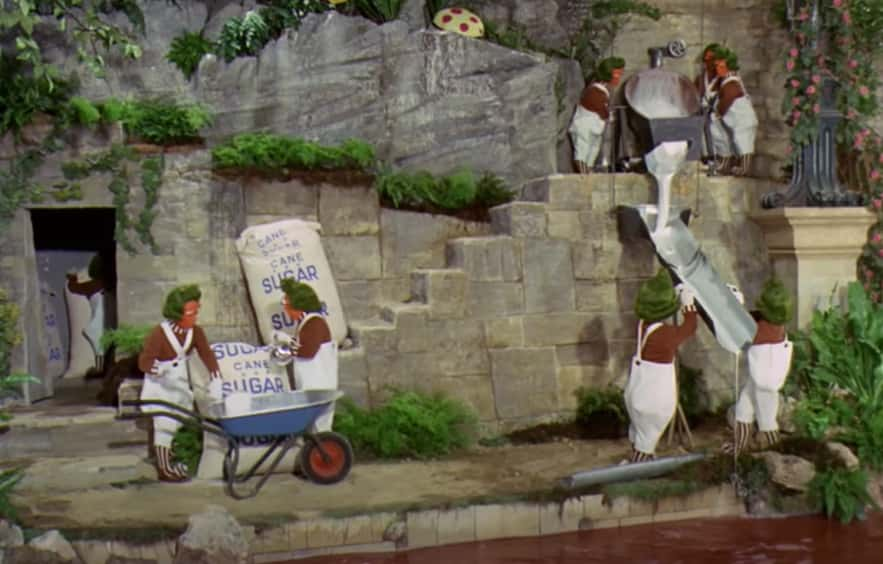"In your wildest dreams you could not imagine that such things could happen to you! Just wait and see!"—Charlie and the Chocolate Factory
Roald Dahl published Charlie and the Chocolate Factory in 1964, and his story has since grown to become a classic of children's literature. Two movies, a stage musical, radio dramas and a hugely successful real-life candy company have all spun off of this sweet novel about a boy and a crazed candyman, but it's road to bookshelves everywhere wasn't exactly as smooth as it could have been. Make sure you brush your teeth after these 42 facts about the delectable novel.
1. Childhood Fantasy
When Roald Dahl was a child, he had the opportunity to taste test chocolates for Cadbury. The chocolatier would send Dahl’s school boxes of chocolate with twelve bars wrapped in foil. One was the control bar, and the others were new flavors. The young Dahl would dream about being a chocolate inventor, and that idea came back to him when it came to writing his second children's book. All I ever got at my school was stale pizza.

2. Got It All Wrong
When Dahl’s daughters Tessa and Olivia were children, he would make up bedtime stories for them. One of those stories was about a boy who lived near a chocolate factory. He wrote a first draft, but later admitted that he "got everything wrong" and that his nephew told him it was "rubbish." The original story had a young boy going to a chocolate factory, falling into a giant vat of chocolate, and being sucked into a machine that trapped him in a chocolate figurine. The actual story is pretty disturbing at times, but I don't think it's quite that horrifying.
3. Grandpa Atticus
In 2003, Gregory Peck was offered the role of Grandpa Joe in the Burton film. He said that he’d consider it but passed before he could give them an answer. According to his family, he was really looking forward to being in the film and only stalled so as not to seem desperate.
4. Immediate Hit
When Charlie and the Chocolate Factory was published in the US in 1964, it sold 10,000 copies in the first week and was highly acclaimed. As of 2016, the combined sales for all editions of the book were 990,711. Not too shabby, Roald.
5. Genuine Reaction
In the 1971 movie version of the book, the reactions on the children’s faces when they entered the chocolate room for the first time were real. None of the kids had seen that part of the set prior to filming.
 Willy Wonka & the Chocolate Factory (1971), Paramount Pictures
Willy Wonka & the Chocolate Factory (1971), Paramount Pictures
6. Turned Him Down
While the book was an immediate success in the US, finding a publisher in the UK was a bigger challenge. One editor told Dahl’s biographer “I could see that Dahl would be popular with children, but publishing for them has to involve more than that somehow." Another editor told Dahl’s most recent biographer that she was proud to have turned it down twice. Some folks just can't admit when they've made a mistake!
7. Not to His Liking
Roald Dahl was extremely unhappy with the Wilder film and the only time he ever watched it for any length of time outside of the premier was by accident in a hotel room. When he realized what was on television, he quickly changed the channel to avoid seeing any more of it.
 Willy Wonka & the Chocolate Factory (1971), Paramount Pictures
Willy Wonka & the Chocolate Factory (1971), Paramount Pictures
8. Chocolate Spies
In the book, Willy Wonka’s reason for closing his factory to the public was due to a fear of spies stealing his secrets. Dahl got the idea from a period during the 1920s when real chocolatiers were in such fierce competition that they sent spies to take each other’s creations. During Dahl’s childhood, stories about the vicious competition between Cadbury and Rowntree were well-known. I just want to meet the guy who got to say his job was "candy spy."
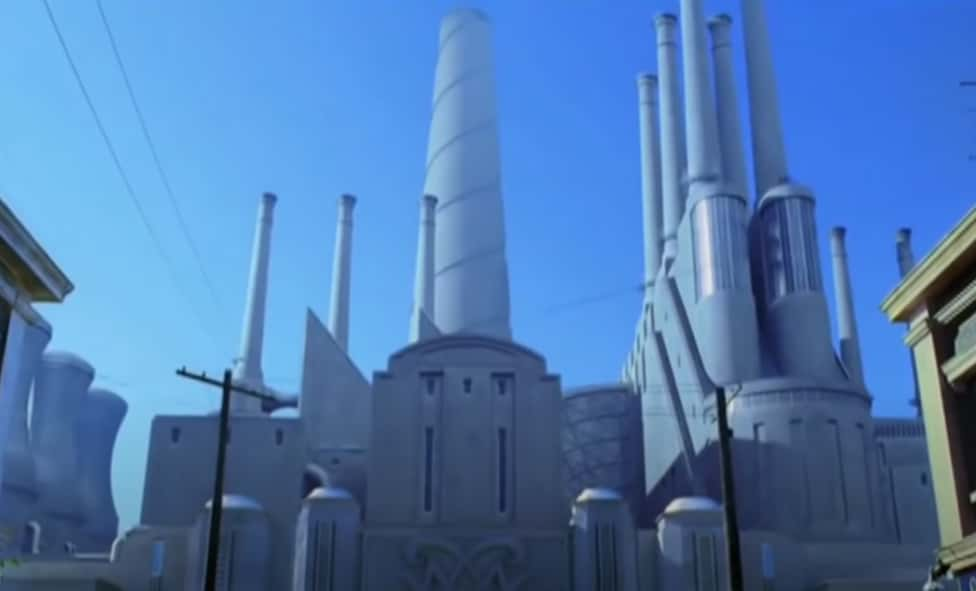 Charlie and the Chocolate Factory (2005), Warner Bros.
Charlie and the Chocolate Factory (2005), Warner Bros.
9. It Just Takes One
Thanks to movie magic, one man played all of the Oompa-Loompas in the 2005 movie version. Deep Roy repeated the same movements hundreds of times and they were put together digitally. As compensation for literally playing hundreds of characters, he earned a salary of $1 million.
 Charlie and the Chocolate Factory (2005), Warner Bros.
Charlie and the Chocolate Factory (2005), Warner Bros.

Sign up to our newsletter.
History’s most fascinating stories and darkest secrets, delivered to your inbox daily. Making distraction rewarding since 2017.
10. I'll Drive
The boat in the chocolate river in the 1971 movie was on a track, but the actor playing the Oompa Loompa at the wheel genuinely believed he was steering the boat. To keep the scene as believable as possible, the director, Mel Stuart, elected not to tell the actor the truth. I bet he thought he was doing just a STELLAR job.
 Willy Wonka & the Chocolate Factory (1971), Paramount Pictures
Willy Wonka & the Chocolate Factory (1971), Paramount Pictures
11. Breaking Reality
Sammy Davis Jr. wanted to play the candy store owner in the Wilder film, but the director refused him, saying that having a big star in the scene would “break the reality.” In the end, while he didn’t get to be in the actual film, his version of the Candyman song from the movie became a core part of his stage shows. Better than nothing!
12. Before Its Time
In an earlier version of Charlie and the Chocolate Factory, Charlie was a little black boy. The decision to change him to white came at the urging of his agent, who thought that having a black protagonist wasn’t a good idea. According to Dahl’s biographer Donald Sturrock, she thought the black character wouldn’t appeal to readers, and that people would simply wonder why he was black. Dahl eventually caved to the pressure and made the switch.
 Willy Wonka & the Chocolate Factory (1971), Paramount Pictures
Willy Wonka & the Chocolate Factory (1971), Paramount Pictures
13. A Number of Names
The development for the 2005 movie version of Charlie began in 1991—twenty years after the release of the original. Prior to Tim Burton coming on board to direct, big names such as Gary Ross and Martin Scorsese were reported to have been involved. Warner Brothers also spoke to or considered a number of actors for Willy Wonka, including Nicholas Cage, Michael Keaton, Brad Pitt, and Will Smith. A Scorsese Chocolate Factory starring Will Smith? You'd better believe I'd watch that!
 Charlie and the Chocolate Factory (2005), Warner Bros.
Charlie and the Chocolate Factory (2005), Warner Bros.
14. Ten Too Many
In the published version of the book, five kids win golden tickets to enter the factory, but in the lost first draft, there may have been as many as 15 kids. In later versions the number was reduced to ten kids, but Dahl evidently realized that even that was too many and further reduced the number.
15. Hidden Messages
The buttons on the Great Glass Elevator in the Burton film actually had messages written on them. Some of the buttons read Blackberry Sausages, Yankee Doodles, Root Brew Goggles, and Black Box of Frogs, and Secretarial Poodles. But which one means ground floor? I can never tell.
 Charlie and the Chocolate Factory (2005), Warner Bros.
Charlie and the Chocolate Factory (2005), Warner Bros.
16. Cut Chapters
Several chapters were cut from the finished version of Charlie and the Chocolate Factory. Since its inital release, some of the lost chapters have been rediscovered among Dahl’s papers and made available online. In one of the lost chapters, the children visited the Vanilla Fudge Room. The room has a huge jagged mountain, at least five storeys high, made of “pale-brown vanilla fudge.” In that case, you can go ahead and call me a mountaineer, because I'm summiting that peak!
 Willy Wonka & the Chocolate Factory (1971), Paramount Pictures
Willy Wonka & the Chocolate Factory (1971), Paramount Pictures
17. The Batman Connection
Tim Burton directed the original Batman movie, and sharp-eyed fans might have caught a nod to the Joker in his version of Charlie. The product that's manufactured at the toothpaste factory where Charlie's father works is named Smilex—same as the name of the products created by Jack Nicholson's Joker in Batman.
 Charlie and the Chocolate Factory (2005), Warner Bros.
Charlie and the Chocolate Factory (2005), Warner Bros.
18. Other Interested Parties
Several other actors were interested in playing the Willy Wonka role that Gene Wilder made so iconic. All of the members of Monty Python were interested, as well as Peter Sellers, who called Dahl and asked for the part, and Dahl’s friend Spike Milligan, whom Dahl personally pushed for. Must have felt pretty good for Dahl to have all those legends egging to play his character, can't say they made a bad choice in Wilder though.
 Willy Wonka & the Chocolate Factory (1971), Paramount Pictures
Willy Wonka & the Chocolate Factory (1971), Paramount Pictures
19. Miranda Mary Piker
A character named Miranda Mary Piker, who ultimately ended up being cut from the book, falls into the chocolate waterfall and gets turned into peanut brittle. According to Dahl, she was the “filthiest, rudest, and most disobedient creature you could imagine.” She didn’t disappear entirely though—in 1973, her chapter was published as a short story called Spotty Powder in Puffin Post Magazine.
20. Permanently Scarred
The actress who played Veruca Salt in the original film ended up cutting and scarring her leg when she smashed a large chocolate egg on a rock that she thought was a prop. In the first scene with the egg, viewers can spot blood on her left stocking and the scar remains to this day.
 Willy Wonka & the Chocolate Factory (1971), Paramount Pictures
Willy Wonka & the Chocolate Factory (1971), Paramount Pictures
21. Too Short
Before casting Gene Wilder, the producers wanted actor Joel Grey to play Willy Wonka. The only problem was: Grey was only five feet tall, and they were concerned that if any of the kids grew while they were filming, they could end up being taller than Grey and looming over him.
22. At His Daughter’s Urging
If not for director Mel Stuart’s daughter, Willy Wonka and the Chocolate Factory might never have been turned into a movie. Stuart’s daughter loved the book and she brought it home to her father, telling him that she’d read it three times and that she wanted him to make a movie of it. By sheer coincidence, Stuart had been speaking with an advertising agent who represented Quaker Oats, and they were looking for a project that would tie in with a chocolate bar they were producing. I think we all owe that young girl a thank you!
23. WHIPPLE-SCRUMPETS
Other than Charlie’s name, almost all of the other character names were changed by the final version of the book. The Oompa Loompas were originally Whipple-Scrumpets, Violet Beauregarde was originally Glockenberry, and Willie Wonka was Mr. Ritchie. The name Wonka came from a boomerang that Dahl and his brother invented as children called the Skilly Wonka.
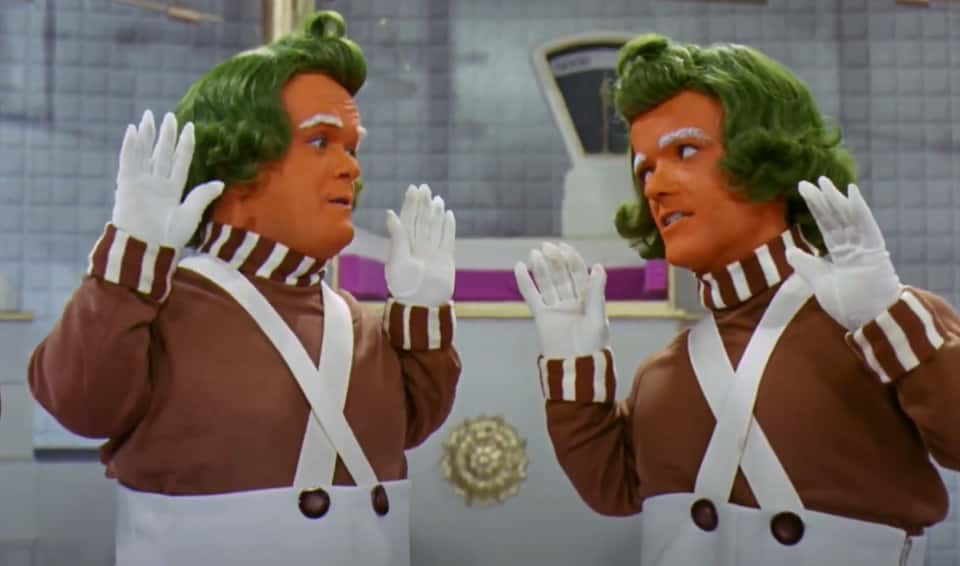 Willy Wonka & the Chocolate Factory (1971), Paramount Pictures
Willy Wonka & the Chocolate Factory (1971), Paramount Pictures
24. Music History
The songs that the Oompa Loompas sing in the Burton film each represent a different musical era, as did Wonka’s comments after. Augustus Gloope’s song was in the style of a Broadway musical, Violet Beauregarde's was disco, Veruca Salt's was psychedelic and Mike Teevee's was rock.
 Charlie and the Chocolate Factory (2005), Warner Bros.
Charlie and the Chocolate Factory (2005), Warner Bros.
25. Those Horrible Children
The inspiration for the four nasty children in Charlie and the Chocolate Factory were based on Dahl’s well-known dislike for children who were greedy and ignorant, and for his hatred of televisions. Chill out Dahl, jeez.
 Charlie and the Chocolate Factory (2005), Warner Bros.
Charlie and the Chocolate Factory (2005), Warner Bros.
26. Wardrobe Input
Gene Wilder largely contributed to the look of his character in the film. After seeing sketches of his costume, he wrote a letter to the director with notes about his jacket pocket, shoes and pants. The height and color of his iconic hat was also Wilder’s idea. He wrote: “The hat is terrific, but making it two inches shorter would make it more special. Also a light blue felt hat-band to match with the same light blue fluffy bow tie shows a man who knows how to compliment his blue eyes.” You've gotta admit: the man knows what he wants.
 Willy Wonka & the Chocolate Factory (1971), Paramount Pictures
Willy Wonka & the Chocolate Factory (1971), Paramount Pictures
27. A Flop and a Hit
The original film featuring Gene Wilder was, at the time of its release, a massive box office flop and only made $4 million. The Tim Burton version, on the other hand, was a box office hit and grossed over 100 times that. But the Wilder version went on to become a cult classic, and let's be honest, when was the last time you thought about watching the Burton movie?
 Charlie and the Chocolate Factory (2005), Warner Bros.
Charlie and the Chocolate Factory (2005), Warner Bros.
28. Credited to Dahl
The lyrics to four of the Oompa-Loompa songs from the Burton version were taken from the original book and Roald Dahl was credited as the writer. Danny Elfman wrote the music and also contributed his own vocals to the Oompa Loompas.
29. Shifting the Focus
When Charlie and the Chocolate Factory first became a movie, the title changed to Willy Wonka and the Chocolate Factory. There were two central reasons for this change: One is that the NAACP wanted the movie title changed so as not to promote the book (which they thought was prejudiced). More importantly, Quaker Oats, who financed the movie, decided to call their chocolate bar the Wonka bar and the film was renamed Willy Wonka to tie-in. If you ask me, I honestly like Willy Wonka better, but don't tell any diehard Dahl disciples that.
 Charlie and the Chocolate Factory (2005), Warner Bros.
Charlie and the Chocolate Factory (2005), Warner Bros.
30. Wonka’s Machines
In the Tim Burton film, the machines that make the three-course meal gum are real machines. They make the the Wonka brand's jawbreakers, AKA gobstoppers, which I'll take over some gross meat-and-potatoes gum any day of the week.
 Charlie and the Chocolate Factory (2005), Warner Bros.
Charlie and the Chocolate Factory (2005), Warner Bros.
31. Significant Re-writes
Roald Dahl is credited as the screenwriter for Willy Wonka, but the script resembled very little of his original screenplay. David Seltzer of Omen fame did major re-writes, and added in several literary allusions to Shakespeare, Oscar Wilde, and other famous authors, because that's what the story really needed.
32. Not a Fan
Gene Wilder would not watch the 2005 remake of the film. He disliked the use of CGI to create the sets, and he was also not a fan of Tim Burton. Tell me how you really feel Gene.
33. The Drafts
Five drafts of Charlie and the Chocolate Factory are housed at the Roald Dahl Museum and Story Centre in Great Missenden, Buckinghamshire. Unfortunately, Dahl is believed to have destroyed the first draft, which has never been found.
34. Wanted a Wild Thing
Dahl wanted a then unknown artist by the name of Maurice Sendak to illustrate the first edition of the book. Unfortunately for Dahl, Sendak was too busy, and it's likely the reason he was predisposed is because he was working on another children's classic, Where the Wild Things Are. Joseph Schindleman ended up illustrating the first US edition, and based the design for Charlie on his son.
35. A Top Pick
Author J.K. Rowling, creator of the equally beloved Harry Potter series of books, ranks Charlie and the Chocolate Factory as one of the top ten books that she believes every child should read. She’s apparently not alone in this belief, as a 2012 study by the University of Worcester found that it was one of the most common books that adults in the UK had read as children, and it’s the second of four books listed in a School Library Journal list of “Top 100 Chapter Books.” I must admit, studies and lists are all well and good, but I'll take Rowling's word over all that any day of the week.
36. A Different Take
When Johnny Depp took on the role of Willy Wonka for the 2005 film, he insisted on playing it completely differently than Wilder had. He felt that Wilder’s character stood out, and he and Burton decided to base their Wonka on children’s TV hosts and game show hosts. If nothing else, you've got to admire their decision to create their own look.
 Charlie and the Chocolate Factory (2005), Warner Bros.
Charlie and the Chocolate Factory (2005), Warner Bros.
37. More Faithful
The Tim Burton film version is a much closer adaptation of the novel than the Wilder film. The new film cut down Slugworth’s role to just a cameo and completely omitted Mr. Beauregarde. These two characters played fairly major role in the 1971 film, but were not nearly as present in the novel.
 Charlie and the Chocolate Factory (2005), Warner Bros.
Charlie and the Chocolate Factory (2005), Warner Bros.
38. Real Squirrels
For the Nut Room scene in the 2005 movie version, Tim Burton insisted on using real squirrels. The squirrels were trained for ten weeks prior to filming, beginning as newborns. They were taught to sit on a bar stool, tap and open a walnut, and to put the nut onto a conveyor belt. That's more than my dog can do!
 Charlie and the Chocolate Factory (2005), Warner Bros.
Charlie and the Chocolate Factory (2005), Warner Bros.
39. The Book that Never Was
In addition to the sequel Charlie and the Great Glass Elevator, Dahl also planned for a third book to round out the trilogy. At the time of him passing in 1990, he was working on a never-completed story called Charlie in the White House.
40. On One Condition
When Gene Wilder agreed to play the titular role in Willy Wonka and the Chocolate Factory, he did so on one condition: He wanted to make his first entrance carrying a cane and walking toward the crowd limping. Once the shocked crowd reacted to his decrepit stature, his cane would sink into the cobblestones and stand up by itself while he kept walking. At the moment Wonka realized he no longer has his cane, he was to pitch forward as though he’s about to face plant on the ground, but instead do a somersault and bounce back up to great applause from the onlookers. Who knows where Wilder got the idea for such a specific request, but it ended up being one of the most iconic character introductions in movie history.
 Charlie and the Chocolate Factory (2005), Warner Bros.
Charlie and the Chocolate Factory (2005), Warner Bros.
41. Tragedy Gets in the Way
Sadly, Dahl had to get through multiple horrible family struggles before getting Charlie published. In 1960, Dahl gave a revised version of his original chocolate story to his agent, but his son was nearly lost his life in an accident shortly after and needed urgent care for several months, so it ended up being shelved. A few years later, he returned to the book, but tragedy struck again when his daughter Olivia passed from the measles, so he put it down once more. Eventually he picked it up again, and finally, Charlie was born.
 Charlie and the Chocolate Factory (2005), Warner Bros.
Charlie and the Chocolate Factory (2005), Warner Bros.
42. Made the Right Call
When news of the book’s adaptation to film was announced in 1970, the NAACP accused Dahl of prejudice, complaining that the treatment of the Oompa Loompas, who were originally black pygmies from Africa, was similar to slavery. Dahl insisted that there was no prejudiced intent and was sympathetic to the NAACP. For the second US edition he changed them to white, hippy-like dwarfs who came from Loompaland. For the film version, they avoided any discussion of race by giving them green hair and orange skin.


